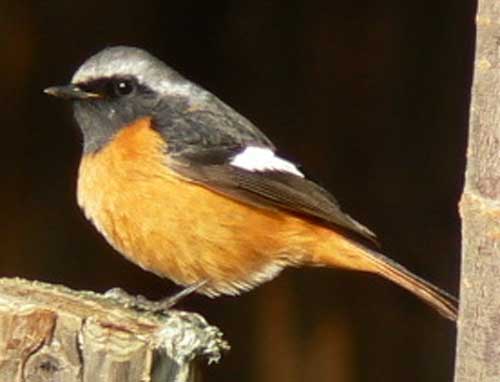
Phoenicurus auroreus (*)
Superregnum: Eukaryota
Cladus: Unikonta
Cladus: Opisthokonta
Cladus: Holozoa
Regnum: Animalia
Subregnum: Eumetazoa
Cladus: Bilateria
Cladus: Nephrozoa
Superphylum: Deuterostomia
Phylum: Chordata
Subphylum: Vertebrata
Infraphylum: Gnathostomata
Megaclassis: Osteichthyes
Cladus: Sarcopterygii
Cladus: Rhipidistia
Cladus: Tetrapodomorpha
Cladus: Eotetrapodiformes
Cladus: Elpistostegalia
Superclassis: Tetrapoda
Cladus: Reptiliomorpha
Cladus: Amniota
Classis: Reptilia
Cladus: Eureptilia
Cladus: Romeriida
Subclassis: Diapsida
Cladus: Sauria
Infraclassis: Archosauromorpha
Cladus: Crurotarsi
Divisio: Archosauria
Cladus: Avemetatarsalia
Cladus: Ornithodira
Subtaxon: Dinosauromorpha
Cladus: Dinosauriformes
Cladus: Dracohors
Cladus: Dinosauria
Cladus: Saurischia
Cladus: Eusaurischia
Subordo: Theropoda
Cladus: Neotheropoda
Cladus: Averostra
Cladus: Tetanurae
Cladus: Avetheropoda
Cladus: Coelurosauria
Cladus: Tyrannoraptora
Cladus: Maniraptoromorpha
Cladus: Maniraptoriformes
Cladus: Maniraptora
Cladus: Pennaraptora
Cladus: Paraves
Cladus: Eumaniraptora
Cladus: Avialae
Infraclassis: Aves
Cladus: Avebrevicauda
Cladus: Pygostylia
Cladus: Ornithothoraces
Cladus: Ornithuromorpha
Cladus: Carinatae
Parvclassis: Neornithes
Cohors: Neognathae
Cladus: Neoaves
Cladus: Telluraves
Cladus: Australaves
Ordo: Passeriformes
Subordo: Passeri
Infraordo: Passerida
Superfamilia: Muscicapoidea
Familia: Muscicapidae
Genus: Phoenicurus
Species: Phoenicurus auroreus
Subspecies: P. a. auroreus – P. a. leucopterus
Name
Phoenicurus auroreus (Pallas, 1776)
References
Reise durch verschiedene Provinzen des Russischen Reichs 3: 695.
Vernacular names
Deutsch: Spiegelrotschwanz
English: Daurian Redstart
Esperanto: Orientazia ruĝvostulo
español: Colirrojo Dáurico
français: Rougequeue aurore
magyar: Tükrös rozsdafarkú
日本語: ジョウビタキ
한국어: 딱새
монгол: Дагуур галсүүлт
Nederlands: Spiegelroodstaart
polski: Pleszka chińska
русский: Сибирская горихвостка
中文(简体): 北红尾鸲
中文(繁體): 黃尾鴝
The Daurian redstart (Phoenicurus auroreus) is a small passerine bird from temperate Asia. The species was first described by Peter Simon Pallas in 1776.
Description and systematics
Its length is 14 to 15 cm and its weight is 11 to 20 g.[2]
Like all typical redstarts, they are strongly sexually dimorphic. Breeding males have a grey crown and nape with lighter forehead and crown-sides, a black face and chin, brownish mantle and wings and a large white wing patch; the chest, lower back and rump are orange, and the tail is black with orange sides. Juvenile males are similarly patterned but much duller and less clearly marked.[2]
Females are warm brown above, paler below, have an orange rump and tail sides, and have a large white wing patch similar to the males. Bill, eye, legs and feet are black in both sexes.[2]
It was formerly classed as a member of the thrush family (Turdidae), but is now generally considered to be an Old World flycatcher (Muscicapidae). This species is divided into two subspecies, the eastern P. a. auroreus and the western P. a. leucopterus.
It belongs to a close-knit Eurasian clade which also includes the black redstart (P. ochruros), Hodgson's redstart (P. hodgsoni), the white-winged redstart (P. erythrogastrus) – which may be especially closely related to P. auroreus – and perhaps the Ala Shan redstart (P. alaschanicus). These all diverged during the latter part of the Late Pliocene and the earliest Early Pleistocene, some 3–1.5 million years ago, during onset of the Quaternary glaciation.[3][2]
[[:File:딱새.ogg|]]
Duration: 56 seconds.0:56
A song of daurian redstart
Problems playing this file? See media help.
Distribution and ecology
It is found in Manchuria, southeastern Russia, northeastern Mongolia, central China and Korea. It is migratory; P. a. auroreus winters in Korea, Japan, southeast coastal China and Taiwan, and P. a. leucopterus in northeast India and parts of Southeast Asia.[1][2]
Daurian redstarts favour open forests, forest edges, agricultural margins, and are also commonly found in parks and urban gardens. They are reasonably confiding and often allow humans to approach quite closely before moving off. It breeds in the summer months, with a mated pair of the nominate subspecies having been encountered in early May.[2][4]
Widespread and rather common, this bird is not considered a threatened species by the IUCN.[1]
References
BirdLife International. (2016). Phoenicurus auroreus. The IUCN Red List of Threatened Species. doi:10.2305/IUCN.UK.2016-3.RLTS.T22710066A94232476.en
Brazil, Mark (2009). The Birds of East Asia: China, Taiwan, Korea, Japan, and Russia. Princeton University Press. ISBN 978-0-691-13926-5.
Ertan, Kemal Topaç (2006). "The evolutionary history of Eurasian redstarts, Phoenicurus". Acta Zoologica Sinica. 52 (Supplement): 310–313. Archived from the original on 2014-05-25.
Bangs, Outram (1932). "Birds of western China obtained by the Kelley-Roosevelts expedition". Field Museum of Natural History, Zoological Series. 18 (11): 343–379 – via Internet Archive.
Retrieved from "http://en.wikipedia.org/"
All text is available under the terms of the GNU Free Documentation License

